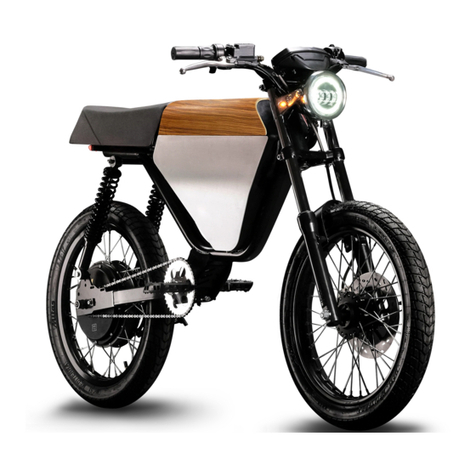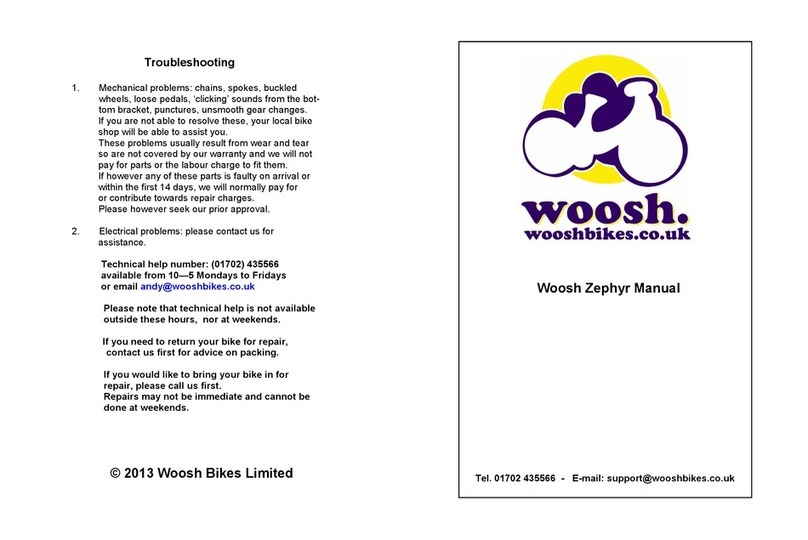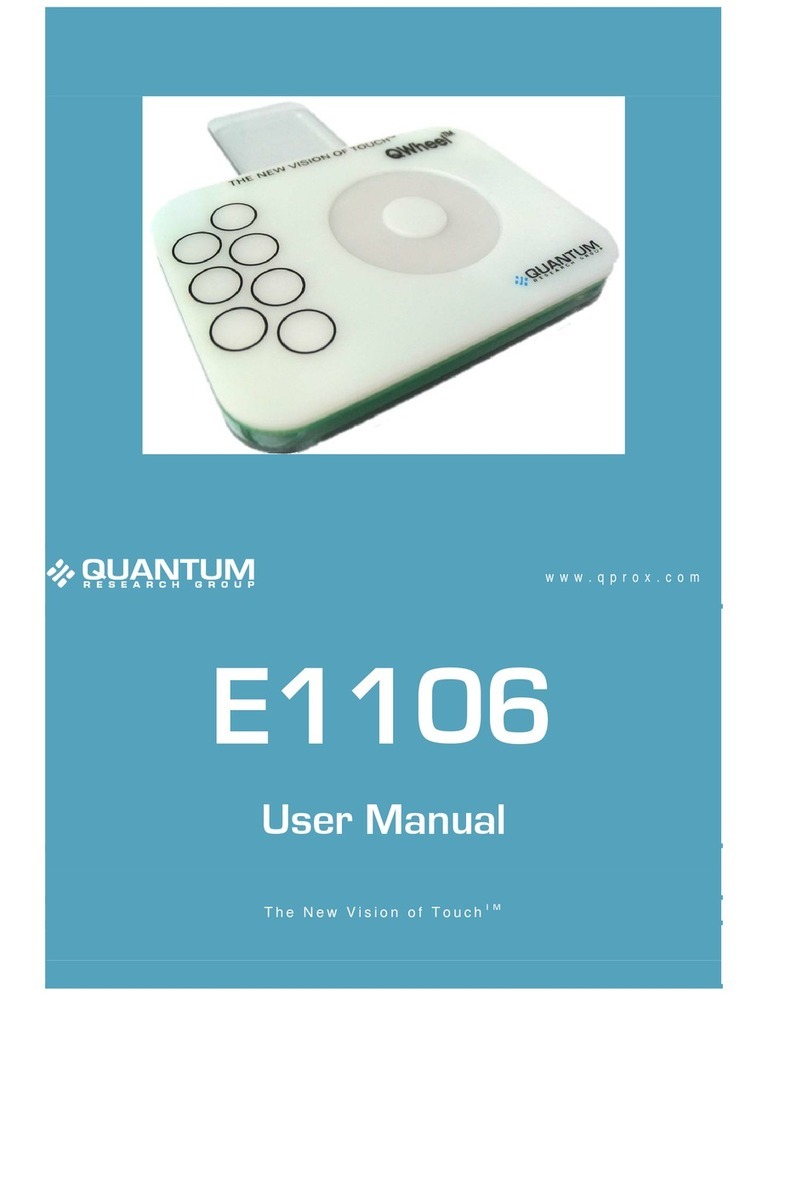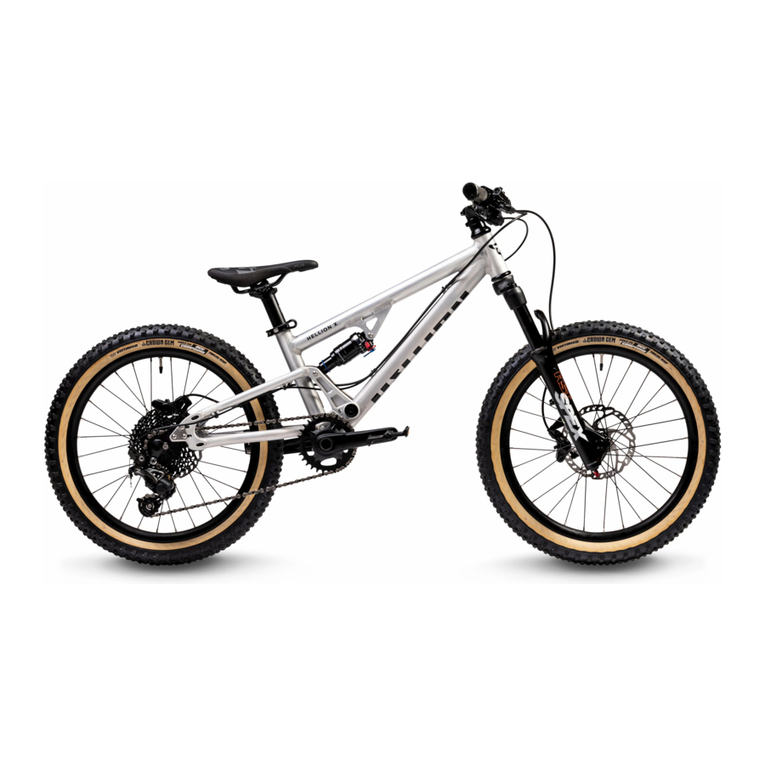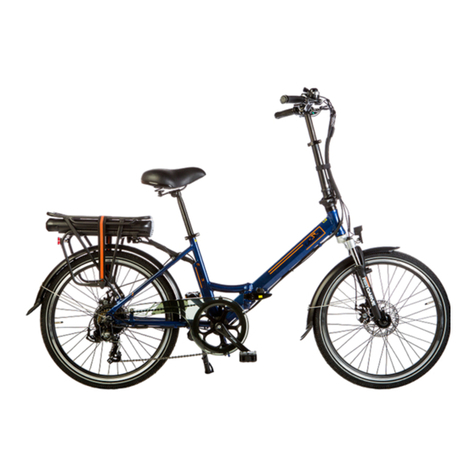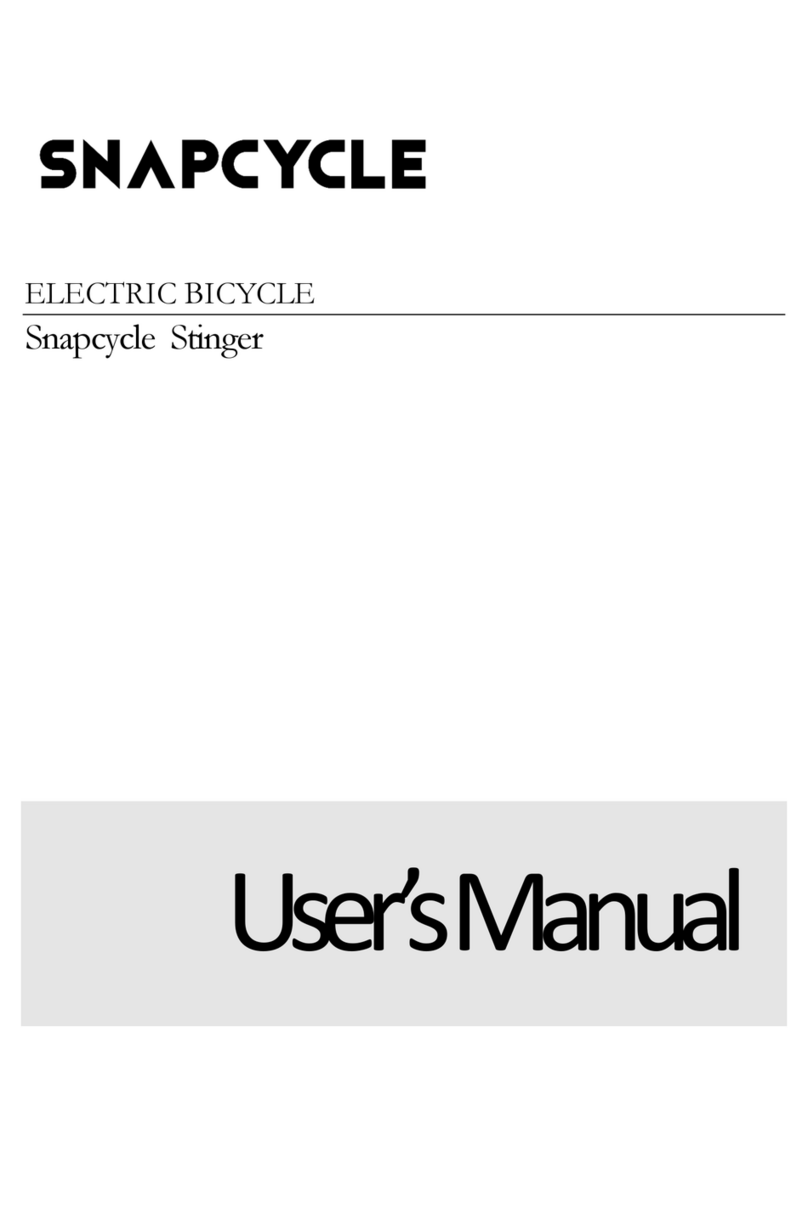Shanghai Leisheng Dynamics VIVANA User manual

Carried Standard: GB17761-1999
Owner’s Manual
(Battery Type: Lithium Battery)
Shanghai Leisheng Dynamics Technology Co.,Ltd.
Address: No.5788, Huyi Road Jiading District Shanghai
Phone:021-59583532
Website: www.shanghaileisheng.com

II
Contents
1. Notes..........................................................................................................................1
2. Bicycle type & use condition.....................................................................................1
3. Structure figure of E- bicycle.....................................................................................2
4. Safety height mark.....................................................................................................3
5. Before the first ride....................................................................................................4
6. Before every ride........................................................................................................6
7. Night riding................................................................................................................6
8. Braking system...........................................................................................................7
9. Shifting gears ...........................................................................................................11
10. Reflectors...............................................................................................................14
11. Use of battery pack ................................................................................................16
12. Main technical parameters.....................................................................................18
13. Charging.................................................................................................................19
14. Charging warnings.................................................................................................20
15. Start the bicycle & adjust PAS...............................................................................20
16. Other notes.............................................................................................................21
17 Simple trouble shooting..........................................................................................21
18. Maintenance...........................................................................................................22
19. Tips.........................................................................................................................24
20. Important reminders...............................................................................................24

III
Congratulations on your purchase of Vivana electric bicycle.
Dear users! For your and others’ safety and also for ensuring the excellent and
stable performance of the bicycle, please ride your bicycle only after your careful
reading this manual.
The daily form and maintenance knowledge offered in this manual will enable you
to be familiar with the steering of the bicycle. Any improper operation may damage
your bicycle.
Owing to the constant technical improvements to the bicycle, the material object
may be a little different from the explanations presented in this manual. Therefore,
everything is subject to the material object.
Please read carefully and observe the contents indicated by the symbol“”.

1
1. Notes
Before riding, for your riding safety, please read the manual carefully and check
the components are functioning properly. Contact your dealer if there are
problems.
Please observe traffic regulations; slow down in rain, snow and icy conditions;
increase the braking distance to guarantee your safety when to brake.
This bicycle is rain and snow proof, but not water-proof. Pay great attention to
that the inner circuits of the whole bicycle could be short circuited and the electric
instruments are damaged when the hub of the rear wheel motor is submerged in
water.
The battery adopted by the bicycle belongs to safe power supply, but more than
two hard contacts on the output end of the battery rack cannot be touched with
wet hands at the same time, much less with the metals. Otherwise, great
short-circuit current may be caused, which, in turn, may result in accidents.
Please pay more attention to this point!
Do not dismantle the components by yourself. For replacing the components,
please purchase the standard ones from our company.
For the safety of other people, please do not lend the bicycle to anyone who is
unfamiliar with it so as to avoid accidents.
2. Bicycle type & use condition
There is a wide range of electric bicycles. Ours are LEV (light electric vehicles).
Each type of the electric bicycle is designed and assembled in accordance to the
particular purpose and use condition. The bicycles (or components) may go wrong if
they bear the ultimate pressure. The use condition for the electric bicycles is presented
in this section. Please consult your dealer when you are not sure of the bicycle type
you are using.
Use condition
Bikes designed for riding on a paved surface where the tires do not lose ground
contact.
Bikes designed for riding on smooth gravel roads and improved trails with
moderate grades where the tires do not lose ground contact.
The maximum weight of the rider is about 300 lbs (136 kg).

2
3. Structure figure of E- bicycle
(1)Frame
(2)Front Fork
(3)Saddle
(4)Seat Post
(5)Handlebar
(6)Handlebar Stem
(7)Grip
(8)Gear Lever
(9)Brake Lever
(10)Bell
(11)Console
(12)Front Hub
(13)Rim
(14)Tyre
(15)Front Brake
(16)Front Mudguard
( 17)Spokes
(18)Tire Valve
(19)Mudguard Stay
(20)Rear Mudguard
(21)Chain Guard
(22)Crank Arm
(23)Kickstand
(24)Chain
(25)Pedal
(26)Rear Derailleur
(27)Freewheel
(28)Hub Motor
(29)Rear Rack Stay
(30)Rear Rack
(31)Battery Pack
(32)Seat Post Clamp
(33)Rear Brake
(34)Frame Pullback Spring

3
4. Safety height mark
Saddle position
When you sit on the saddle, your legs can slightly straighten with both feet on the
ground, and then the saddle height is the most suitable. If your feet can not touch the
ground when riding, you may fall. Therefore, you must adjust the saddle height
carefully.
Seat post MAX mark, also insertion mark, can not be raised beyond the quick
release collar. If improperly used, serious injury may be caused to the rider (See
Figure 1).
Saddle angle: for preventing the rider leaning forward when riding, the front end
of the saddle is preferably upwarped slightly; adjust the saddle forward or
backward according to your height, generally, it is preferable that the seat post is
fixed in the middle of the saddle.(see Figure 2)
Handlebar stem height
Handlebar stem height can be adjusted according to your preference, but the

4
maximum height mark should be invisible. If improperly used, serious injury may be
caused to the rider. (See Figure 3)
5. Before the first ride
Make sure the bicycle fits
Your dealer should fit you with the proper size of bicycle. There should be at least
1inch (25 mm) clearance between the top tube and the rider when standing over the
bicycle (Figure 4). For mountain bikes, 2-3 inches (50-75 mm) clearance is
recommended. The seat and handlebar may be adjusted to offer the best comfort and
performance.
Know how the bicycle performs
The features of your bicycle, if misused, may cause you to lose control of the bike.
Before riding fast or in more difficult conditions, learn the function and performance
of all the mechanisms of your bike by riding at slower speeds in a flat, empty parking
lot.
If you want your bicycle to perform differently, or if you have special needs that
require different parts for the safe operation of your bike, consult your dealer.
Learn the power of your brakes
The stopping power on bikes varies according to the intended use of the bike. If you
would like your bike to have more, or less, stopping power, consult your dealer about
brake adjustments or other brake options for your bicycle.
WARNING
Misuse of the braking system, including over-use of the front brake, can cause you
to lose control and fall. Avoid improper braking by understanding and practicing
proper application of your brakes as explained in this manual.

5
Avoid your feet touch the front mudguard
When riding slowly, do not pedal if the handlebar is turned. It may be possible that
at very slow speeds, when the handlebar is turned, your feet may contact the front
wheel or mudguard (Figure 5). At normal riding speeds, the handlebar does not turn
enough for this to occur.
WARNING
Contact between your feet and the front wheel or mudguard can cause you to lose
control and fall. Avoid pedaling when turning at slow speed.
Stop riding, if the frame or front fork has problems
Occasionally riders experience problems with their frame or fork. If a frame or fork
has any problem, do not ride the bicycle.
As an example, in very rare cases, some riders may experience a “shimmy” or
“harmonic oscillation” or “frame vibration” at certain speeds. If you are experiencing
a shimmy, slow down immediately. Take your bicycle directly to a dealer for
inspection and repair.
WARNING
A shimmy, or steering wobble, can cause you to lose control and fall. If you
experience a shimmy, slow down immediately. Take your bicycle to your dealer for
inspection and repair.
Figure 4Minimum stand-over height Figure 5Toe-clip overlap
1 = 1" (25 mm) for most bicycles
2-3" (50-75 mm) for mountain bicycles

6
6. Before every ride
Checks before riding
For your riding safety, checks before riding should include the following items below:
Check tyre pressure.
Check the front and rear wheels are tightened. The torque setting of the front
wheel clamp nut is not less than 19.6 Nm and that of the rear wheel clamp nut is
not less than 30 Nm.
The torque setting of the clamp nuts of handlebar and handlebar stem is not less
than 19.6Nm. The inserted part of the handlebar stem should be no less than 2.5
times the length of the diameter of handlebar stem(that is to say, the safety line
around the handlebar stem should be invisible).
The torque setting of the clamp nuts of saddle and seat post is not less than
19.6Nm. The inserted part of the seat post should be no less than 2.5 times the
length of the diameter of seat post(that is to say, the safety line around the seat
post should be invisible).
There should be between 5-10 mm total vertical movement of the chain.
The brake should be adjusted to be reliable and flexible. Increase the braking
distance in rain and snow.
Check to ensure the quick releases for the bicycles that can be folded are
tightened!
7. Night riding
Riding a bicycle at night is many times more dangerous than riding during daylight
hours. It can be more difficult for motorists and pedestrians to see you while riding
your bicycle at night. However, a lighting system does not provide the same amount
of light as daylight and therefore we remind you to ride at your own risk. We do
advise that children should never ride at dawn, at dusk or at night and adults ride at
their own discretion.
If you choose to ride under conditions of poor visibility, always check to ensure
you comply with local laws pertaining to riding a bicycle at night and take the
following strongly recommended additional precautions:
Make sure your bicycle’s lighting system is operating properly, is correctly
positioned and securely mounted.
Always wear reflective and brightly coloured clothing and accessories such as
reflective vest, reflective arm and leg bands, and reflective strips on your helmet.

7
Any reflective device and bright lighting systems will help attract attention from
motorist, pedestrians or other cyclists on the road.
Ensure that none of your clothing or accessories are obstructing light fixtures or
reflective pieces.
NOTE:Please check your certified helmet manufacturer’s warranty details to ensure
that adding a reflective strip does not void the warranty before attaching anything to
your helmet. If in doubt, contact your local dealer for assistance.
While riding at dusk, dawn or in conditions of poor visibility, ride safely and
cautiously. Avoid dark areas or areas with heavy or fast moving traffic. Avoid road
hazards and if possible, ride on familiar routes. If this is not possible, try to find
well-lit routes with minimal traffic.
WARNING:
Please remember that riding at dusk, dawn, at night or in conditions of poor visibility,
without your lighting system operating properly is dangerous and may result in
serious injury or death.
WARNING:
Check to see that your lighting system is operating properly and that the fixtures
(front and back) are clean, straight, unbroken and securely mounted. Have your local
dealer replace or repair damaged fixtures and straighten or tighten any that are bent
or loose. Your dealer can also assist you in repairing any problems with the lighting
system overall. It is a very good habit to regularly check to see that your lighting
system is operating at peak performance.
8. Braking system
Brake levers
The brake system allows you to slow or stop your bike, a function critical to your
safety.
The brake system is difficult to adjust properly without the proper tools and training.
It is strongly recommended that adjustment of a brake be done by your dealer. If you
need more specific information regarding your brake system, contact your dealer.

8
To adjust the position of a lever
1. Locate the lever clamp bolt (Figure 6).
2. Loosen the clamp bolt 2-3 turns.
3. Position the lever.
4. Tighten the clamp bolt:
• Regular brake levers: 6.0-7.8 N•m.
To adjust the brakes
See the Brakes section for brake adjustment procedures.
1. Loosen the take-up of brake cable.
2 Adjust the break cable to the proper length.
3 Inspect the brakes, and re-adjust as necessary.
Figure 6Lever clamp bolt, mountain lever
1- Lever clamp bolt
2- Reach adjustment screw
3- Cable
4- Barrel adjuster
Brakes
Once a month, inspect brake pads for wear. If the grooves in the braking surface are
less than 2 mm deep, or 1 mm deep for direct-pull brakes, replace the pads. Replace
disc brake pads that are thinner than 1.0 mm.
To adjust brake pad clearance to the rim
1. Turn the barrel adjuster. To increase the pad clearance, turn the barrel adjuster
clockwise. To reduce the pad clearance, turn the barrel adjuster out anticlockwise.
For most direct-pull (Figure 7), or cantilever (Figure 8) systems, the barrel adjuster is

9
on the lever.
2. If the brake pads cannot be adjusted properly, loosen the cable clamp bolt and
re-attach the cable.
Figure 7- Direct pull brake Figure 8- Cantilever brake
1- Cable clamp bolt 1- Linkwire
2- No contact 2- Pad fixing bolt
3- Pad fixing bolt 3- Arm fixing bolt
4- Centering screw 4- Centering screw
5-Arm fixing bolt
To center a cantilever brake
1. Rotate the centering screw. Turn in small increments and check for centering.
2. If the brake has two centering screws, adjust the overall spring tension while
centering the brake.
To adjust the alignment of the brake pads on a rim brake
1. Loosen the brake pad fixing bolt.
2. Align the pads , and tighten the pad fixing bolts:
• Caliper: 4.5-6.8 N•m
• Direct-pull or cantilever: 7.9-9 N•m
3. After adjusting the brakes, test them by applying force to the levers. Ensure the
cable does not slip, the pads close toward the rim at right angles, and the pads do
not contact the tire.
To align a disc brake
1. Loosen the brake mounting bolts.
2. Apply the lever fully, and gradually tighten the bolts to 11.3-12.4 N•m.

10
To align a cable-actuated disc brake
There are several parts to this procedure:
To adjust right brake pad clearance to the disc
1. Turn the fixed pad adjuster (Figure 9).
2. If the pads cannot be adjusted properly in this manner, follow the instructions To
adjust left brake pad clearance to the disc, and re-set the right pad.
Figure 9- Disc brake
1- Mounting bolts
2- Fixed pad adjuster
3- Cable clamp bolt
To adjust left brake pad clearance to the disc
1. Turn the cable barrel adjuster. To increase the pad clearance, turn the barrel
adjuster clockwise. To reduce the pad clearance, turn the barrel adjuster
anti-clockwise.
2. If the pads cannot be adjusted properly in this manner, loosen the cable clamp bolt
and re-attach the cable. Tighten the cable clamp bolt to 5.7-7.9 N•m.
3. After adjustment, turn the locking nut clockwise to help prevent rotation of the
barrel adjuster.
To align the brake with the disc
1. Loosen the brake mounting bolts.
2. Slide a business card, or similar thin object, between the right brake pad and the
disc.
3. Apply the lever fully, and gradually tighten the bolts to 11.3-12.4 N•m.

11
To remove disc brake pads
1. Remove the wheel.
2. With your fingers or thin-tipped pliers, grasp the installation tang of the brake pad
and pull out.
To open the brake for wheel removal
For cantilever brakes, release the linkwire. With one hand, squeeze the brake
pads firmly against the rim. With the other hand, pull the leaded end of the
linkwire from the retaining fork on the brake arm. Release the brake pads, and
the brake will open.
To close the brake, reverse the instructions.
For direct-pull type brakes, disconnect the pipe from the link arm. With one
hand, squeeze the pads firmly against the rim. With the other hand, pull the pipe
back from the link arm, and lift the pipe. Once disconnected, let go of the brake
pads and the brake will open.
To close the brake, reverse the instructions.
For internal or drum brakes, to remove the rear wheel, first disconnect the shift
and brake cables.
•To disconnect the brake cable, press the cable carrier arm forward, and the cable
clamp bolt rearward, so the bolt aligns with the larger diameter hole in the
carrier. Pull the cable clamp bolt outward to disengage it from the carrier. Slide
the brake cable stop forward to remove it from the brake arm. Undo brake strap
bolt.
•To disconnect the shift cable, put the shifter in 1st gear. Pull the cable housing out
of the shift cable housing stop. Rotate the shift cable fixing bolt until the washer
flats align with the slit in the cog joint bracket. Remove the cable.
9. Shifting gears
Front derailleur
To adjust the small chainring position
1. Shift the chain onto the smallest front chainring and the largest rear cog.
2. Loosen the front derailleur cable clamp bolt (Figure 10) until the cable is free.
3. Turn the low gear adjusting screw (marked “L”) until the inner chain guide of the
derailleur is approximately 0.5 mm from the chain.
4. Pull on the cable end, and down-shift the left shift lever several times so that it is

12
in the small-chainring position.
5. On the shifter or down tube, turn the shift cable adjusting barrel to its most
clockwise position.
6. Insert the cable in the groove found next to the derailleur cable clamp bolt, pull
the cable taut, and tighten the bolt:
• Front derailleur cable clamp bolt- 44-60 lb•in (5.0-6.8 N•m).
To adjust the big chainring position
1. Shift the rear derailleur to the smallest rear cog.
2. Turn the high-gear adjusting screw (marked “H”) anti-clockwise until it cannot
interfere with the motion of the derailleur.
3. Hand-turn the cranks, and use the shifter to carefully shift the chain onto the
outside chainring.
4. Position the outer chain guide of the front derailleur approximately 0.5 mm from
the chain.
5. Re-tighten the high gear adjusting screw until it meets resistance.
If you have turned the screw too far, the front derailleur will move toward the small chainring.
6. Go through the various gear combinations. Make sure the chain does not fall off
when you shift, and the derailleur cage does not rub on any part of the crankset.
To adjust the middle gear position, with three chainrings
1. Shift the chain onto the largest front chainring and the smallest rear cog.
2. Rotate the cable tension barrel-adjuster (on the down tube or on the lever)
counter-clockwise, increasing cable tension to align the inner derailleur cage until
it just touches the chain.
3. Go through the various gear combinations to ensure the chain smoothly lines up
with all the chainrings.
NOTE:
some front shifters have a ‘tab’ feature: slightly downshift the lever and the
derailleur will move in slightly, no longer touching the chain.
Figure 10- Front derailleur
1- Cable
2- Adjusting screws
3- Cable clamp bolt

13
Rear derailleur
To adjust the small cog position
1. Shift the chain onto the smallest rear cog and the largest front chainring.
2. Loosen the cable clamp bolt (Figure 11) until the cable is free.
3. Stand behind the bicycle to see that the smallest rear cog, the chain, and the two
derailleur pulleys are in line.
4. If they are not aligned, turn the high gear adjusting screw (usually marked “H”,)
until this line is established.
5. While pulling on the cable, up-shift until the shifter is in the small cog position.
6. On the shifter or down tube, turn the adjusting barrel all the way clockwise. Turn
the adjusting barrel on the rear derailleur all the way clockwise, and then one turn
anti-clockwise.
7. Insert the cable into the clamp bolt groove on the rear derailleur, pull the shift
cable taut, and tighten the cable clamp bolt to 44-60 lb•in (5.0-6.8 N•m) .
Figure 11- Rear derailleur
1- Adjusting screws
2- Barrel adjuster
3- Cable clamp bolt
4- Cable
To adjust the large cog position
1. Turn the low gear adjusting screw on the rear derailleur (usually marked “L”) far
enough counter-clockwise that it will not restrict the movement of the derailleur.
2. Carefully shift the chain onto the smallest front chainring and the largest rear cog.
Do not over-shift the rear derailleur, or the chain may wedge between the large
cog and the spokes.
3. Position the rear derailleur pulleys in line with the largest cog.

14
4. Turn the low gear adjusting screw clockwise until it meets resistance.
If you have turned it too far, the derailleur will move toward the
outside of the bicycle.
5. Go through the various gear combinations. Make sure the chain does not fall off
when you shift.
To align the indexing system
1. Shift the chain onto the largest front chainring and the smallest rear cog.
2. Shift one click with the rear shifter.
3. Check if the chain moves smoothly to the next gear.
• If the chain makes excessive noise or does not shift, turn the
barrel-adjuster counter-clockwise in small increments and check again
for a smooth shift.
• If instead, the chain moves to the third smallest cog, turn the barrel
adjuster clockwise until the derailleur pulleys align with the second
smallest cog.
4. Go through the gear combinations to ensure the chain smoothly lines up with all
the rear cogs.
If the derailleur cannot be adjusted in this manner, the derailleur
hanger may be out of alignment; take the bike to your dealer for
service.
10. Reflectors
Your bicycle is supplied with one front (white), one rear (red), two wheel (white),
and four pedal (orange) reflectors. These are an important safety and leg requirement,
and should remain securely fitted and in good, clean condition at all times.
Periodically, inspect all reflectors, brackets and mounting hardware for signs of wear
or damage. Replace immediately if damage is found. Some bicycles require you to
install your reflectors onto your bicycle. Please refer to the following section for
instructions on all the types bicycle reflectors.

15
Fork mount reflector bracket assembly
First, insert one washer onto the hex bolt and insert hex bolt through the reflector
bracket and then through the fork. Next, insert a second washer onto the bolt and
thread a hex nut onto the bolt behind the fork. Tighten bolts until snug, making sure
the reflector is in an upright position. See diagram at the right.
Front reflector mount with caliper brake assembly
First, remove the hex nut from the back of the fork and pull the brake from the fork.
Insert a spacer, washer and the reflector bracket on to the caliper bolt. Insert the
caliper bolt back into the fork and secure firmly with a concave spacer, washer and
the hex nut. Finally, adjust the reflector such that it is in an upright position. See
diagram at the right.
Seat and handlebar mounting reflectors
First, attach the reflector to the reflector bracket with the reflector screw, see the top
diagram. Next, remove the clamp screw and open the clamping reflector bracket.
Place clamping reflector bracket around the handlebar or seat post. If the clamp is too
loose, insert the shim inside of the clamp. Tighten the clamp screw to hold reflector
assembly in place, see the second diagram. Finally, adjust the reflector assembly in
place and ensure that it is upright and facing away from the bike.
Seat stay mount reflector bracket assembly
First, insert one washer onto the hex bolt and insert hex bolt through the reflector
bracket and then through the seat stay bridge. Next, insert a second washer onto the
bolt and thread a hex nut onto the bolt behind the seat stay bridge. Tighten bolts until
snug, making sure the reflector is in an upright position. See the diagrams in the next
page.

16
11. Use of battery pack
Structure of battery pack
(1) Power Lamp (2) Charging Socket (3) Power Key
(4) Fuse Holder (5) Battery Pack Lock (6) Output Receptacle
How to use the battery back
Procedure:
1. Normal condition of the battery pack

17
2. Unlock the battery pack with the battery pack key, pull the battery pack backward,
and see the following figure.
3. Lift to take out the battery pack, see the following figure.
4. Slide the battery pack into the battery holder and lock it after charging.
Table of contents
